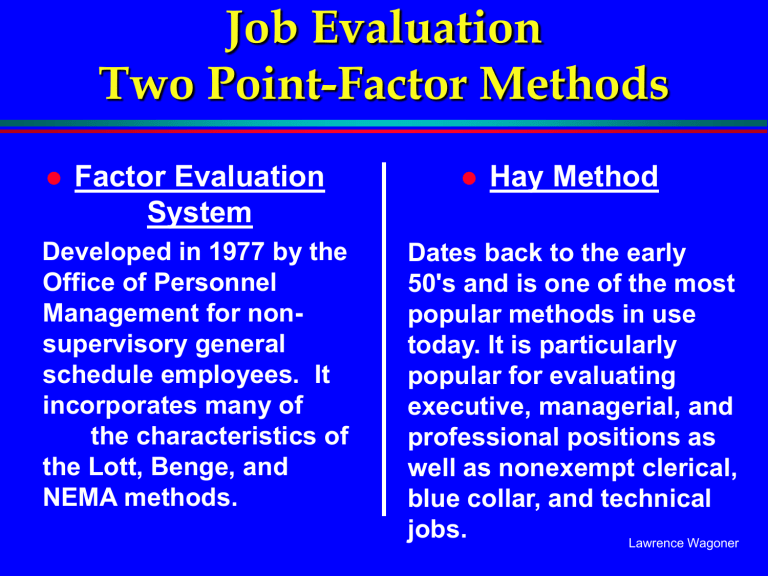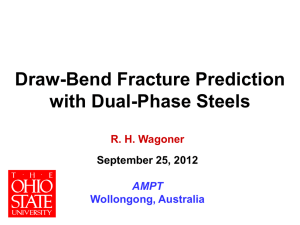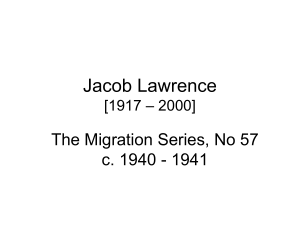Wages & Salary Admin

Job Evaluation
Two Point-Factor Methods
Factor Evaluation
System
Developed in 1977 by the
Office of Personnel
Management for nonsupervisory general schedule employees. It incorporates many of the characteristics of the Lott, Benge, and
NEMA methods.
Hay Method
Dates back to the early
50's and is one of the most popular methods in use today. It is particularly popular for evaluating executive, managerial, and professional positions as well as nonexempt clerical, blue collar, and technical jobs.
Lawrence Wagoner
Universal Factors
Four Popular Methods
BASS
Skill
(4/0)*
Working Condition
(3/0)
Responsibility
(1/0)
NMTA
Skill
(3/15)
Effort
(2/10)
Responsibility
(4/20)
Job Conditions
(2/10)
* (SUBFACTORS/DEGREES OR LEVELS)
Lawrence Wagoner
Universal Factors
Four Popular Methods
Hay and Purves Factor Evaluation System
Know How
(3/15)
Knowledge
(2/9)
Personal Contact
Purpose of Contact
Problem Solving Supv Control Physical Demands
(2/13) (3/5) Work Environment
Accountability
(3/15)
Guidelines
(2/5)
Complexity
(3/6)
Scope & Effect
(2/6)
Lawrence Wagoner
Combining Point-Factor and Factor-Comparison Methods
A critical check of the results of a POINT-
FACTOR job evaluation involves the use of
FACTOR COMPARISON.
It is used to be sure that the factor points assigned to each job makes sense relative to a factor comparison process.
Lawrence Wagoner
Job Evaluation Committee
Essential to the success of all job evaluation processes is the presence of expert judgment.
Lawrence Wagoner
Job Evaluation Committee
Expert judgment is typically shaped by the level of knowledge shared by the evaluators of the work environment....Their understanding of the nature of the work being performed, and....Their capacity to process information and data and make sound judgments.
Lawrence Wagoner
Job Evaluation Committee
The quality of the output of any job evaluation process using point scored compensation factors relates directly to the quality of decisions made by those doing the ratings, and....
Lawrence Wagoner
Job Evaluation Committee
It is reasonable to assume that given the complex nature of work environments, accuracy in job evaluation requires the knowledge and skill of more than one individual, and....
The logical consequence is the job evaluation committee.
Lawrence Wagoner
Job Evaluation Committee
A job evaluation committee may consist of one to three permanent members (at least one from the comp department) and rotating members representing the unit(s) whose jobs are being evaluated.
Lawrence Wagoner
Roles Of The Committee
Rank And Rate Jobs
Select A Job Evaluation
Methodology
Choose Benchmark Jobs
Lawrence Wagoner
Role Of The
Compensation
Department
Provide Committee Representation
Provide Committee With Staff Specialists
Identify Benchmark Jobs
Provide Training For Committee Members
Lawrence Wagoner
Factor Evaluation
System
The FES differs from the other pointfactor methods in that it contains three stages of descriptive data not simply a defined set of universal compensable factors, subfactors, and degrees.
The three stages are:
Lawrence Wagoner
Factor Evaluation System
Primary Standards (9)
Factor-level Descriptions For The Series
(60+)
Benchmark Jobs That Cover The Full
Range Of Pay For The Jobs In Each
Occupation Or Series.
Lawrence Wagoner
FES Factor Description
Table
FACTOR
LEVELS
Knowledge
Supv Control
Guidelines
Complexity
Scope/effect
Pers Contact
Purp Of Contact
Phys Demand
Work Environment
Total Points
POINTS
50-1850
25-650
25-650
25-450
25-450
10-110
20-220
5-50
5-50
4480
% TOTAL
41.3
14.5
14.5
10.0
10.0
2.5
4.9
1.1
1.1
6
4
5
6
9
5
4
3
3
Lawrence Wagoner
FES Exercise
The FES process is described in detail in the text on pages 257 through 277.
Additionally, a job description for a lead programmer taken from chapter 7 has been evaluated on pages 271 through 274 using the
FES process and the results have been summarized on a "factor evaluation system position evaluation statement" appearing on page 276.
Lawrence Wagoner
FES Quality Check
There is a direct relationship between the selected level of the knowledge factor and levels selected of all other factors.
The knowledge or skill requirements of a job drive the evaluation rating, while other compensable factors provide additional information to "fine tune" the final rating.
Review figure 9-5 "FES knowledge level conventions" for further explanation or description of this point.
Lawrence Wagoner
Sore Thumbing
Reviewing ratings using some kind of spreadsheet layout assists in identifying factor ratings that don't make sense.
This analysis is often called "sore thumbing" because an inappropriate rating stands out like a sore thumb.
Lawrence Wagoner
Hay Guide Chart-Profile
Method
The Hay Guide chart-profile method uses three universal factors, eight subfactors, and forty-three degrees and levels to evaluate jobs.
They are as follows:
Know-How
Practical procedures, specialized knowledge, And scientific discipline.
(8 levels)
Managerial (4 levels)
Human relations (3 levels)
Plus 3 degree choices per grid.
Lawrence Wagoner
Hay Guide Chart-Profile
Method
Problem-Solving Accountability
Thinking environment
(8 levels)
Thinking challenge
(5 levels)
Plus 2 degree choices per grid
Freedom to act
(7 levels)
Job impact on end results (4 levels)
Magnitude
(4 levels)
Plus 3 degrees per grid.
Lawrence Wagoner
Hay Method
The descriptions that form the rows and the columns of the guide charts provide a measure of the level of difficulty, or importance, of each factor.
The KH and AC guide charts provide actual scores. The PS guide chart provides a percentage that identifies the amount of KH used in solving problems.
Lawrence Wagoner
Hay Method
The Guide Charts Have Both Standardized
And Customized Features:
The geometric scales use the same values with each step, reflecting the 15% perceptible difference in values theory discussed in chapter six.
The number of rows and columns of each guide chart can be altered to fit the character and size of the client.
Lawrence Wagoner
Hay Method
The evaluation process generally begins with the highest valued compensable factor and proceeds in order to the lowest weighted factor.
Lawrence Wagoner
Hay Method
KNOW-HOW
Rows describe depth and breadth of job knowledge required to perform job assignments.
Columns describe management breadth relative to such requirements as planning, organizing, reviewing, and control.
Within each column there is a third element that measures human relations skill.
Lawrence Wagoner
Hay Method
PROBLEM-SOLVING
Rows identify levels of thinking.
Columns identify thinking challenge.
When the most appropriate grid and corresponding percentage has been identified, a point value is determined by multiplying the selected PS% (x) the previously determined KH points.
Lawrence Wagoner
Hay Method
ACCOUNTABILITY
Rows measure freedom to act
Columns measure the magnitude of the impact of the job on end results
Inside each column is a third element that measures the job impact on end results (4 per column)
Lawrence Wagoner
Hay Method Example
The same lead-programmer analyst job evaluated earlier in this chapter using the
FES method is re-evaluated in pages 282-
294 using the hay method.
Figure 910 (pg 284) is a ”Hay Position
Evaluation Statement" that contains the evaluation scores for the lead-programmer analyst in accordance with the hay guide chart-profile method.
Lawrence Wagoner
Hay Method
Quality Checks And Patterns
PROFILING
KH and PS are closely linked in the guide charts and they tend to parallel each other with respect to their alpha numeric locator codes. As KH requirements increase for a job PS enjoys a concomitant growth.
Lawrence Wagoner
Hay Method
Quality Checks And Patterns
PROFILING
PS and AC also have a relationship that provides information about the general nature of jobs that when examined either validates the evaluation or challenges the results.
Lawrence Wagoner
Hay Method
Quality Checks And Patterns
PROFILING
Jobs higher in PS points than AC points are typically staff and administrative in nature, and....
Jobs higher in AC points than PS points are typically action or line jobs, and....
Lawrence Wagoner
Hay Method
Quality Checks And Patterns
PROFILING
Jobs with essentially the same AC and PS points tend to have an administrative/action orientation.
The profile is determined by identifying the step difference between PS and AC....
Lawrence Wagoner
Hay Method
Quality Checks And Patterns
The step difference is determined
By locating the PS points on the
Step value guide and counting up
Or down until you have located the AC points. The number of
Steps taken in this procedure establishes the step difference. The
Direction (up +, down -) defines
The nature of the difference.
Lawrence Wagoner
Hay Method
Quality Checks And Patterns
PROFILING
To convert all of this data into a profile turn to page 287 in your text and find the PS percentage, identified in the sample problem, in the left hand column (33%) and move across that row until you find the KH points in the first row that correspond with those determined in your sample problem (230)....
The number found at this intersection (87) becomes profiling
CONTINUED...
Lawrence Wagoner
Hay Method
Quality Checks And Patterns
PROFILING
The number you locate in the left hand column of the profile table (figure 9-11b) and match up with the appropriate step level (1 down) located on the horizontal axis.
The resulting set of numbers is the job profile (38 33 29). This profile defines the percentage of points assigned to each of the three universal factors.
Lawrence Wagoner
Hay Method
Quality Checks And Patterns
PROFILING
All to the job profiles lined up in order of point totals will provide the organization with a profile pattern that further validates the evaluation effort.
Lawrence Wagoner
Hay Method
Quality Checks And Patterns
PROFILING
As a rule, KH points as a percentage of the total tends to decrease as job value increases.
PS and AC points as a percentage of the total tend to be lowest at the lower valued jobs.
Lawrence Wagoner
Hay Method
Quality Checks And Patterns
PROFILING
Profile patterns are also indicators of job rank within an organization:
General Mgr
Plant Mgr
Operations Mgr
Office Mgr
KH-PS-AC
41-23-36
44-22-34
56-19-25
60-17-23
Lawrence Wagoner







